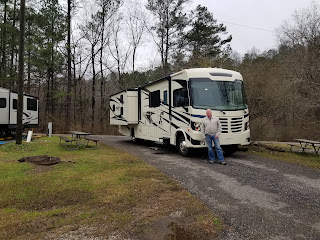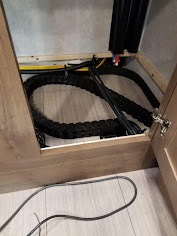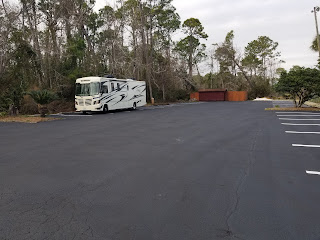Forest River FR3: 5 Things to Know Before You Buy

“What do you wish you knew before you bought this Forest River FR3 32DS motorhome?”
Yesterday, my son asked me if we had any surprises or disappointments with our purchase of the Forest River FR3 32D. My initial response was, “No, it was pretty much what we expected.” But, as I thought about it, Mark and I have had some “surprises,” especially since we bought our 2019 with 5700 miles on it from a private seller and we didn’t get the orientation that is often provided by a dealership. We watched YouTube videos, downloaded the owner’s manual, and looked through spec sheets, in addition to touring and driving multiple models. But these are the things that we didn’t know or completely understand before our first Class A purchase.

1. Entry-level Quality:
We knew that the quality and workmanship on an entry-level model would be lower than a pricier unit, but we did not anticipate the number of small fixes that we would do in the first month of ownership. Here are just a few.
- The trim comes off randomly around the interior. We have corner trim that has been re-secured twice in the bathroom and the trim came loose around the stove, too. The problem occurs because all trim is attached with small tack-like nails without sufficient head size to keep them from pulling through the wood.
- The edge of the “fake” countertop is coming loose in several places and needed to be re-glued or caulked.
- The thin plywood cover under the king bed drawers has detached and could impact the retraction of the rear slide. A few nails were needed.
- The plastic pipes under the bathroom sink leaked briefly and needed to be turned and tightened.
- The edge of the dinette table had rough edges that had to be sanded and sealed.
- One of the flexible heat ducts has came apart from the vent so that the warm air filled the compartment under the couch instead of exiting from the vent near the steps.
- None of the exterior door locks could be key locked. Every one of them had to be removed and realigned so the baggage doors were secured. Some of these locks were put on upside down, so Mark turned them so they were all vertical when locked.
- The deadbolt on the door did not engage properly and needed to be adjusted.
- The driver’s window latch fell off the first time the window was opened and had to be re-secured.
- The latch on the bathroom shower door fell off and was replaced.
- The bolts holding the exterior refrigerator vent cover broke off and had to be replaced.
- The slide hoses are encased with a flexible, plastic loom that retracts into the space under the kitchen sink. Ours already had 4 pieces that had become unlinked and were wedged under the sink along with a couple of long screws and several pieces of an industrial-strength zip tie. (Perhaps that was part of the problem.) The loom makes a flexible covering that guides and protects your gas and electrical lines as the slide is moving. Be careful! Even after fixing the links in the loom, removing the debris, and ensuring that the loom worked properly, another “link” became kinked yesterday while retracting the slide. We need to look for more trouble-shooting answers such as lubricating the track under the sink to reduce friction. In the meantime, watch carefully so you don’t damage your slide or lines.
- The mattresses are cheap and uncomfortable. After the first night, we bought a 3-inch memory foam topper. Huge improvement!!!! Plan on replacing this if you want to get any sleep.

2. Missing Comfort Features:
Until we purchased this Forest River , we assumed (I know that is never a good thing to do…) that all models had a converter and an inverter. We were wrong. This model lacks an inverter. So, for us, that means that we have no power to electrical outlets while we are unhooked from shore power or traveling. We have had to be extra vigilante to charge computers and our hotspot before longer trips so that Grace can do her school assignments. So, by the passenger chair, I have two three-pronged outlets, but neither will work while we are traveling unless we run the generator.
The manual for this unit says, “If there is an inverter…” I recommend adding an inverter if this is an optional upgrade. Without one, the only outlets that work during travel are the USB plugs. We have no power to the microwave, TVs, 12-volt outlets, or power outlets while driving. At least we can power the GPS or our phones.
We also dislike that this model has no fan in either of the roof vents. We are finding out how important that is for reducing the humidity after showers and minimizing sewer tank odor. A Max Air Vent, like the one in this link, will be in our future. It would be nice to have that ventilation.
3. Lower Maneuverability:
We opted for a shorter model, overall the Forest River FR3 32DS is actually 34 feet long, so that it would easily fit in our driveway, national parks, and parking lots, especially since we opted not to tow an additional vehicle. I have been surprised, though, at the number of obstacles we have had to avoid even after only a month. Our unit is 13′ 6″ and we have had multiple low-hanging branches that hit the roof or sides of the motorhome. City streets are the worst! Without a toad, we have been able to access our desired destinations so far, but this motorhome does not “feel” small when traveling. We park at the back of Walmart for groceries and look for areas in the far reaches of restaurant lots. Plan to get your steps in!
4. Noise:
After driving several models, we knew that we would hear rattling and engine noise in any entry model gas Class A. With the engine under our feet, it was expected, but we are anxious to minimize that noise. The sound is annoying on bumpy roads, and Alabama interstate highways were some of the worst! One of our first upgrades will be sound-deading mats, for under the “doghouse” to reduce engine noise. We are opting for the 80mil Kilmat over the 50 mil version, if that gives you any idea of the noise problem! I also investigated random squeaks and rattles as Mark was driving and added foam adhesive dots to rattly areas like the plastic shield on the entry door, the window shades, around the screen door, behind the TVs, and even around some of the cabinet doors. We have yet to figure out how to get rid of the whistling around the entry door, but we are hoping that between conditioning the door seals and adding some weather stripping, we will solve this problem as well.
5. Living with Slides Retracted:
After our first night boondocking in a Pilot station where we could not extend our slides, we met the challenge of sleeping without a walk-around bed. This was not a surprise, but still a challenge. The doorway to the bedroom is narrow for my 6-foot husband and he had to crawl over the foot of the bed to get to the bathroom. We survived. Also, I am still struggling with organizing so that everything we need is accessible with the slides retracted. Remember, the cabinet under the sink and all of the drawers in the bedroom, including the ones under the bed, are inaccessible. That means that you cannot access the trash can under the sink from its typical location. I have discovered that I can reach under the upper sink cabinets to retrieve boxes of cereal, but it is difficult. We need more planning if we are going to boondock often.
Summary:
Before buying our FR3 32DS motorhome, we heard from many owners that you have to be capable of making repairs or willing to learn. With the backlog at many repair centers, I am thankful for my mechanical husband. Our FR3 still needs some upgrades, tweaks, and minor repairs, but we are exploring and learning as we go. I am so thankful that we found our motorhome, but at some point, we may choose to upgrade. Only time will tell. In the meantime, let’s get out and explore!






